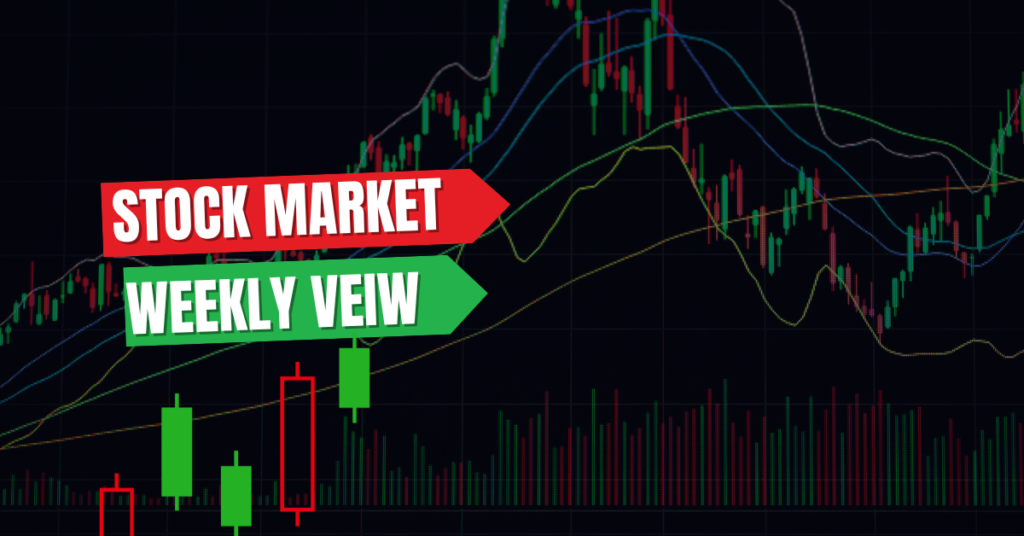Table of Contents
Recommended For You
In this report, dated October 6, 2024, we will examine these assets’ technical and fundamental aspects through their charts, including the Nifty 50 and Bank Nifty chart, and discuss how global events might impact the Indian stock market and other financial markets. I’d like you to please stay updated with the latest stock market news and analysis.
Gold and Silver: Current Scenario
At present, gold prices are hovering near their all-time highs, with values lingering around ₹76,000 per 10 grams over the past four to five days. An important point to note is that when the market consolidates, i.e., prices remain stable, it is not a sign of weakness but rather of strength. This indicates that buyers are cautiously waiting to enter the market at this level.
Will Gold See Further Upside?
The support level for gold has solidified around ₹75,000. Given the current global circumstances, the chances of gold prices declining seem slim. The key drivers for the upward trend in gold prices are:
- Geopolitical Tensions: Particularly between Iran and Israel.
- Interest Rate Cuts: As central banks, especially in the U.S., lower interest rates, the U.S. dollar weakens, leading to increased demand for safe-haven assets like gold.
If interest rates continue to drop, it will directly impact currencies, leading to depreciation. As the value of currency drops, investors tend to invest more in physical assets like gold, driving up its price.

Next Potential Targets
If gold holds the ₹75,000 support level, the next key levels to watch for are ₹78,000 and ₹80,500. In the coming months, gold is likely to test these levels, especially considering the current geopolitical and macroeconomic environment.
Crude Oil: Rising or Falling?
Now let’s turn to crude oil. After experiencing some volatility in recent days, crude oil has returned to $75 per barrel. The upward trend in oil prices could continue in the near future. OPEC (Organization of the Petroleum Exporting Countries) and other Middle Eastern countries often try to stabilize prices through production cuts or strategic meetings.
OPEC prefers to keep oil prices near $80 per barrel as this is the most favorable for their economies. Long-term deviations above or below this price level are unlikely due to market forces.
Impact on Indian Markets
Indian stock markets, particularly Nifty 50 and Bank Nifty, have faced a decline over the past week. Meanwhile, global markets like Hong Kong and Shanghai have seen positive momentum. The Hang Seng Index in Hong Kong, for example, surged by about 10.5% last week, while Indian markets witnessed a 4.5% decline. This indicates that global investors are pulling out their money from Indian markets and reallocating it to faster-growing markets like China, where government policies are currently more investment-friendly.
China vs. India: Changing Investment Trends
In China, the government continues to announce various stimulus measures to support its economy. Whenever there are signs of a slowdown, China’s central bank immediately cuts interest rates and increases cash flow to boost economic activity. In contrast, Indian companies are facing higher taxes and interest rates, causing some investors to seek better returns elsewhere.
The Lack of Investment in Indian Markets
With interest rate cuts and stimulus efforts in China and the U.S., we are seeing capital outflows from Indian markets. Investors are increasingly turning to U.S. markets, such as the NASDAQ and S&P 500, which offer greater liquidity. As a result, Nifty 50 and Bank Nifty have been under pressure, leading to the recent declines.

Analysis of Bank Nifty
The Bank Nifty chart reveals a 7% drop in the index over the past week. This decline occurred primarily from the 54,000 level down to around 51,000. This is a significant drop as the 51,500 support level for Bank Nifty has now been broken. If the market continues to slide, the next major support levels could be between 46,000 and 50,000.
Is the Downtrend Over?
From a technical perspective, Bank Nifty has shown a bounce back near its lower levels, which could indicate some relief in the coming week. However, if the 51,000 level is breached again, further declines could occur.
Nifty 50: Technical Overview
Nifty 50 has also been trading within a channel for the past few weeks, but after the Indian general elections in June 2024, it saw a breakout. However, since last week, Nifty 50 has been experiencing a decline, hovering between ₹19,800 and ₹19,500. This channel remains critical for Nifty 50, and if the market bounces from here, we could see a move above the 20,000 mark in the upcoming weeks.
Key Support and Resistance Levels
If the ₹19,500 level for Nifty 50 breaks, the next major support level will be around ₹19,000. On the upside, resistance levels are expected near ₹20,000 and ₹20,500.
Impact of Global Markets
The ongoing decline in Indian markets can largely be attributed to the shifting focus of global investors toward the U.S. and Chinese markets. The Federal Reserve’s interest rate cuts in the U.S. and the Chinese government’s economic stimulus measures have drawn investor attention. Consequently, we are witnessing capital outflows from Indian markets, putting additional pressure on Nifty 50 and Bank Nifty.
U.S. and China’s Economic Strategy
Both the U.S. and China have been actively trying to boost their economies by lowering interest rates. In the U.S., the rate cuts have weakened the dollar, making U.S. markets more attractive to foreign investors. Similarly, China’s government has announced several economic packages to ensure stability, further encouraging investments in Chinese assets.
The Future of Indian Markets
The key question now is how long the decline in Indian markets will last. The answer depends largely on when and by how much the Reserve Bank of India (RBI) adjusts interest rates. If the RBI follows the trend set by the U.S. and China by reducing interest rates, it will send a positive signal to the markets, likely attracting more investment back into India.
Possibility of Interest Rate Cuts
Although the RBI has not made any significant changes to interest rates yet, given the current global economic situation, there is a growing possibility of rate cuts in the near future. If this happens, it could provide a significant boost to the markets.
Conclusion
In conclusion, Indian markets are currently facing a challenging phase, but it is unlikely to last for an extended period. As soon as interest rates are cut, liquidity will increase, and investors may once again turn to Indian markets. Keep a close watch on the support and resistance levels of Nifty 50 and Bank Nifty in the coming weeks.
Meanwhile, gold and silver remain safe investment options, especially in light of the current global uncertainties. It’s essential to analyze the market from every angle before making any investment decisions.
Stay updated with the latest stock news and stock market news, and make informed decisions as the market evolves.
Disclaimer: The aim of every content at Wall Street Trends is solely for information & educational purposes. financial awareness & literacy in our Bharat!
Thus, We aim to promote We are not SEBI Registered & don’t offer PMS/Advisory, nor any kind of Account Handling Service.
Stock Market Investments are subject to Market Risks.
FAQs: Weekly Analysis of Nifty 50, Bank Nifty, and Global Markets
1. Why is the Indian stock market declining while global markets like China are gaining?
The decline in the Indian stock market, including Nifty 50 and Bank Nifty, can be attributed to capital outflows as global investors shift their focus to markets like China and the U.S. These countries have announced economic stimulus packages and interest rate cuts, making them more attractive for investors. India, by contrast, has not yet implemented similar measures.
2. What is the impact of interest rate cuts in the U.S. and China on the Indian markets?
Interest rate cuts in the U.S. and China weaken their currencies and stimulate economic activity, attracting global investors. This leads to capital outflows from Indian markets, putting pressure on Nifty 50 and Bank Nifty, and causing a short-term decline.
3. What are the key support and resistance levels for Nifty 50?
The current support level for Nifty 50 is around ₹19,500. If this level is breached, the next support could be ₹19,000. On the upside, resistance levels are seen at ₹20,000 and ₹20,500. Monitoring these levels is important for predicting market trends.
4. What are the key support levels for Bank Nifty?
The Bank Nifty index is currently facing a significant support level around 51,000. If this level is broken, it could decline further to the 46,000-50,000 range. Traders should closely watch these levels on the Bank Nifty chart for potential opportunities.
5. How are global geopolitical tensions affecting gold prices?
Gold prices are currently near their all-time highs, driven by geopolitical tensions, particularly between Iran and Israel. Additionally, lower interest rates globally are leading to currency depreciation, which makes gold a preferred safe-haven asset, further pushing its price upward.
6. What are the future prospects for gold prices?
Gold has strong support at ₹75,000, and with ongoing geopolitical risks and interest rate cuts in major economies, gold prices are expected to test levels of ₹78,000 to ₹80,500 in the coming months.
7. Will crude oil prices continue to rise or fall?
Crude oil prices have stabilized around $75 per barrel. Given OPEC’s production strategies and efforts to keep prices near $80, a major price fluctuation is unlikely in the short term. However, any unexpected geopolitical event or changes in OPEC policies could impact prices.
8. What is causing the current volatility in Bank Nifty?
The volatility in Bank Nifty is a result of various factors, including global economic trends, capital outflows, and concerns about higher taxes and interest rates in India. Additionally, investor sentiment is affected by the expectation of a possible interest rate cut by the Reserve Bank of India (RBI).
9. Is the Indian market expected to recover soon?
The Indian market’s recovery will largely depend on the RBI’s future monetary policy. If the RBI announces interest rate cuts, similar to the U.S. and China, we can expect an inflow of capital into Indian markets, which could lead to a market recovery.
10. What should investors focus on in the coming weeks?
Investors should monitor the support and resistance levels of Nifty 50 and Bank Nifty, stay updated on any announcements from the RBI regarding interest rate cuts, and keep an eye on global geopolitical developments. Additionally, keeping track of stock news and stock market news can help investors make informed decisions.
11. Why are interest rate cuts important for the stock market?
Interest rate cuts reduce borrowing costs for companies and individuals, which can stimulate economic growth. Lower rates also lead to currency depreciation, attracting foreign investments and boosting stock market performance.











